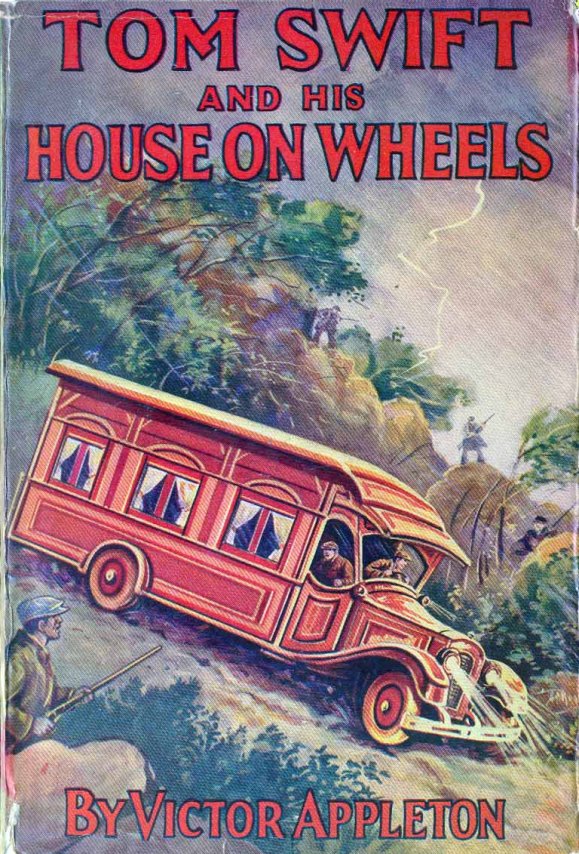|
|
|

|
 January
30, 2007: Tom Swift Behind the Curve January
30, 2007: Tom Swift Behind the Curve
Quite a few people sent me notes yesterday telling me that Tom
Swift absolutely did not invent the RV. There were a fair
number of one-off custom jobs wobbling down the roads since the
very early Twenties. In fact, a commercial RV was being sold to
the public as early as 1928, which was a whole year before Tom
Swift and His House on Wheels hit the bookstores.

There was a custom job called the
Flordellen, built for a wealthy New Yorker named Leonard Whittier
in 1927. It had a full bathroom, a stove, a refrigerator, and Pullman-style
beds, and could  have
served as the model for Tom Swift's dream vehicle. For the hoi polloi
there was the Road Yacht (left) mass produced for a while starting
in 1928. It reminds me a little of Bucky Fuller's Dymaxion
car, for the swoopy contours if nothing else. Supposedly Henry
Ford had a sort of prototypical RV in which he would take junkets
into the wilderness with Thomas Edison and Harvey Firestone. No
photos or real details on that one, but boy, would that have made
for some fine campfire conversation! have
served as the model for Tom Swift's dream vehicle. For the hoi polloi
there was the Road Yacht (left) mass produced for a while starting
in 1928. It reminds me a little of Bucky Fuller's Dymaxion
car, for the swoopy contours if nothing else. Supposedly Henry
Ford had a sort of prototypical RV in which he would take junkets
into the wilderness with Thomas Edison and Harvey Firestone. No
photos or real details on that one, but boy, would that have made
for some fine campfire conversation!
Tom Swift, for once, was behind the curve. On the other hand, I
think modern readers misunderstand the older Tom Swift books a little.
Like all Stratemeyer Syndicate titles, they were extruded from a
sort of juvenile fiction sauage grinder, and the non-negotiable
aspect of each book was not a glipse of the future but adventure.
The old Tom Swift books had more skullduggery and gunplay than anything
in the Tom Swift Jr series, and the gimmick was sometimes a piece
of slightly enhanced present-day technology (like a hotrodded motorcycle
or an electric locomotive) set in the thick of sinister plots and
endless running around. One I remember only vaguely (Tom Swift
Among the Diamond Makers) came off a lot more like Indiana Jones
than anything else.
I haven't come upon a genuine history of the RV, but now that I
know how far back things actually go, it's ascended a few notches
on my to-be-located list. If I find it, you'll read about it here.

|
 January
29, 2007: The Real Inventor of the RV... January
29, 2007: The Real Inventor of the RV...

...was Tom Swift, Sr. Not bad for 1929. And it had a V-12. No Repelatrons,
though.
|
 January
27, 2007: Beambots January
27, 2007: Beambots
 One
of the pleasures of chasing down 119 back issues of Popular Electronics
in recent months was meeting a couple of issues that I had had as
a kid and have since lost. The most important of these, by far,
was the March 1962 issue, the cover story of which was "Emily,
the Robot with the One-Track Mind." I built Emily in the winter
of 1966, and won the Immaculate Conception Grade School 8th Grade
Science Fair with her. Even forty years later, when I ran into my
former classmates at our reunion this past June, people remembered
me as "the robot guy." I still have Emily, and she sits
in a place of honor on the high shelf in my workshop downstairs.
One of the photocells snapped off and needs replacing, but that
done, I suspect she would work as well as she did when I was 13. One
of the pleasures of chasing down 119 back issues of Popular Electronics
in recent months was meeting a couple of issues that I had had as
a kid and have since lost. The most important of these, by far,
was the March 1962 issue, the cover story of which was "Emily,
the Robot with the One-Track Mind." I built Emily in the winter
of 1966, and won the Immaculate Conception Grade School 8th Grade
Science Fair with her. Even forty years later, when I ran into my
former classmates at our reunion this past June, people remembered
me as "the robot guy." I still have Emily, and she sits
in a place of honor on the high shelf in my workshop downstairs.
One of the photocells snapped off and needs replacing, but that
done, I suspect she would work as well as she did when I was 13.
Emily is what we today call a "beambot", because she
follows a beam of light. She had two modes of operation: She would
follow either a beam of light shone on its front photocell, or else
a high-contrast line running beneath it. The line could be black
on white or white on black, because what its electronics sensed
was the change between a highly reflecting surface and a
surface that absorbed light.
Emily worked very simply. She had two independent motors, each
driving a wheel. A relay was wired so that only one motor would
ever run at a time, and when the relay changed state, the running
motor stopped and the "dead" motor started up. When you
turned her on, one of the two motors would run, and Emily would
pivot on her dead wheel until she found either a beam of light on
her front face, or else a change in the reflectivity of the floor
beneath her. At that point, the relay would change state, and the
other motor would start up. By alternating between the two motors,
Emily would in a slightly wobbly way follow the light beam or the
line on the floor. The schematic is amazingly simple:

A self-focusing penlight bulb under the body (I1) cast a beam of
light on the floor, and a selenium photocell (PC2) was mounted where
the beam would go if reflected from a white surface. That's how
it detects a change of reflectivity in the floor. (It would follow
the border between white and black linoleum as well as a line.)
About ten years ago, I helped my nephew build a beambot very much
like Emily, only with Meccano parts and a one-piece LED light source/phototransistor.
The motors were much faster, and it scooted along a six-foot line
of masking tape on the floor in a couple of seconds. Jim Strickland
is building a beambot using a vacuum tube switch instead of a transistor,
on a Lego foundation. There are a lot of ways to go about it. It's
a great project to build with kids, if you know enough basic electricity
to make use of what parts you can find today.
Emily was important to me for another reason: Although my dad paid
for the parts, I insisted on building it in the basement without his
help, and it turned out to be the first major electronics project
I ever built myself that worked perfectly. Before Emily I had had
a lot of trouble making things work. After Emily, well, I knocked
'em over one after the other. I'm not sure what changed: Maybe I paid
more attention to assembly details. Maybe I just got lucky. (I think
a big issue was getting a good VOM for 8th grade graduation and testing
parts before I used them.) Still, she was a huge boost to my
confidence, and in many respects the true boundary in my life between
childhood and adolescence. The next passage of similar importance
was not until I met Carol in 1969. Oh, how women change you!
|
 January
26, 2007: Odd Lots January
26, 2007: Odd Lots
- The other morning, a fox apparently urinated on my Wall Street
Journal (oh, the irony!) which I did not discover until I
went out to pick up the paper from the driveway and got fox pee
all over my left hand. We see the little vandal dashing in and
out of the 24" drain pipe that runs under Stanwell St. next
to the house, and he has a very distinct odor, not anything like
a cat but closer to skunk. Even though the paper was in a plastic
bag, it smelled so badly that we had to pitch it. And my left
hand still smells.
- A "turtle shop" apparently is a turtle shop;
i. e., a place where you buy live pet turtles. Bruce Schneier
unsheathed his Occam's Razor and cut a good guess, and Michael
Covington nailed it by posing the question to Jesse Sheidlower,
one of the editors of the OED, who would know if anybody would.
This was Jesse's response: "In the '30s-'50s or so, small
turtles were popular pets, and one could buy them at souvenir
stores in Times Square (where the Capote passage is set). Usually
they had a name painted on the shell. The stores weren't generally
called 'turtle shops,' i.e. this phrase is descriptive, not lexicalized."
Thanks to all who contributed to the debate. This is one of the
things that makes me glad I live in the era of ubiquitous networking!
- While we're still talking turtles, Michael Covington forwarded
this
piece laying out some additional insights on the turtles-as-Salmonella-threats
debate. I especially like the sentence giving the advice, "Do
not kiss reptiles..." Roger. Wilco.
- From Mark Moss comes a pointer to a slightly weird hack: A
downloadable program that will modify your installation of Windows
XP to make it look like Vista. I'm not entirely sure that
I will try the Vista Transformation Pack, since I have no idea
where it's been, but if I were Microsoft I would let this guy
quietly do his thing, and reap the benefits of what we hope is
the good kind of "viral" marketing. (Maybe in a virtual
machine. I'll give it some thought.)
- Another thought: It occurs to me that I should be able to write
a small program in Delphi that intercepts the CapsLock key and
makes it a Ctrl key. (When was the last time that I—or anybody—actually
used the CapsLock key to lock caps? PEOPLE YELL AT YOU FOR USING
ALL CAPS!!!!!!!) It's humbling to realize that I have long since
forgotten what I knew about hooking the keyboard interrupt. Time
to go digging.
- This slipped past me a year ago: On January 26, 2006, Western
Union quietly ceased its telegram service. Telegrams are history.
I don't recall ever dealing much with telegrams (I think we sent
one from Baltimore in 1985 to counter an offer on our house in
Rochester, NY) but they are very much a part of our culture, like
steam trains and dial telephones, that now exist in cultural memory
rather than in the culture of daily life.
|
 January
24, 2007: The Capacitor Plague January
24, 2007: The Capacitor Plague
Ok. This is serious. If you've been reading my descriptions of
the Dell Optiplex SX-270 machines here on Contra and have considered
buying one on the used market, hold off. Something Funny Is Going
On Here. I ordered two machines (a beat-up 2.8 GHz unit for $250
and a near-mint 2.6 GHz unit for $375) and they have worked flawlessly.
Once I got the peeled-off inventory sticker goop off of them, they
even look reasonably good. Pete Albrecht bought a cheaper machine
for $150, and it worked for ten minutes and croaked.

When he opened it up (see photo above) he found that several of
the electrolytic capacitors on the motherboard were bulging severely
upward, and one of them had actually popped the pressure-release
scores on its top. It didn't take a lot of research to find out
what had happened. Start with the
Wikipedia article on the problem. There are two basic unrelated
failure modes: Some caps (especially from Nichicon) were overfilled
with electrolyte, and popped because there was no room for expansion
within the capacitor body. The other problem is that a Taiwanese
manufacturer evidently stole a formula for electrolytic capacitor
electrolyte, and the stolen formula did not list all the ingredients.
The secret anti-corrosion compound was not included in the stolen
formula, which caused the caps to be filled with an excessively
corrosive electrolyte. This weakened the aluminum cap body and caused
it to fail early. Here's another
item on the espionage issue.
 The
caps have been used in a lot of things, including CF lamp bulbs
(which I have tried and found to fail in only a month or two...hmmmmm...)
but especially computers. The problem is so widespread that there
is even on online forum about it, called badcaps.net.
Astonishingly, some manufacturers are allegedly continuing to use
bad caps in new manufacturing. The only way to avoid the issue completely
is to avoid the use of Taiwanese caps entirely; one site suggests
the Rubycon brand from Japan. (Home constructors take note here:
It's important to test every component before you solder it into
a circuit. An electrolytic cap with measured capacitance more
than 20% below the marked value should not be used. Pitch
it.) Dell
acknowledged the issue back in mid-2005, and has supposedly
been good about replacing the bad mobos. They have a
sort of supplemental warranty for capacitor failure in SX270, GX270
and GX280 models that is good until January 31, 2008, or five
years after the date of original puchase (whichever is earlier)
which is probably the manufacture date for used machines. The
caps have been used in a lot of things, including CF lamp bulbs
(which I have tried and found to fail in only a month or two...hmmmmm...)
but especially computers. The problem is so widespread that there
is even on online forum about it, called badcaps.net.
Astonishingly, some manufacturers are allegedly continuing to use
bad caps in new manufacturing. The only way to avoid the issue completely
is to avoid the use of Taiwanese caps entirely; one site suggests
the Rubycon brand from Japan. (Home constructors take note here:
It's important to test every component before you solder it into
a circuit. An electrolytic cap with measured capacitance more
than 20% below the marked value should not be used. Pitch
it.) Dell
acknowledged the issue back in mid-2005, and has supposedly
been good about replacing the bad mobos. They have a
sort of supplemental warranty for capacitor failure in SX270, GX270
and GX280 models that is good until January 31, 2008, or five
years after the date of original puchase (whichever is earlier)
which is probably the manufacture date for used machines.
As best we can tell from combing the Web, not every SX270 is prone
to the problem. The ones to avoid are older units with service tags
that end in 21 and 31. These are generally machines with manufacture
dates in 2003 or before. Pete's machine's service tag ends in 31;
both of mine end in 41. So I have hopes that mine will stay alive,
but I'm watching them closely. The service tag can be found on an
adhesive label on the left-hand panel of machines mounted vertically,
or on the bottoms of machines mounted horizontally. See the photo
above. Thanks to Don Bullard, we found a
Dell lookup page that accepts a service tag and tells you when the
machine was built. This will help you take advantage of the Dell
capacitor warranty if it fails.
|
 January
23, 2007: The Avant Stellar Keyboard January
23, 2007: The Avant Stellar Keyboard

I just received my new Avant
Stellar keyboard from CVT, Inc. I've mentioned this before in
Contra: It's a new build of the legendary Northgate OmniKey keyboards.
The OmniKey 102 was standard gear back at The Coriolis Group in
the early 1990s, when in addition to editing PC Techniques Magazine,
I spec'ed, ordered, and assembled all company hardware on the corner
of my desk. (The company was pretty small back then.) When the company
grew and we retired the older systems, I spirited away five of the
keyboards, three of which are still at least mostly functional.
Considering how I pound a keyboard, and considering that they were
built no later than 1993, I think this is pretty remarkable.
However, nothing lasts forever, and I figured I had better scout
out a source of OmniKey keyboards or at least repair
service. You can get them on eBay, and occasionally in other
online stores, but the Avant Stellar intrigued me, because it was
brand new: CVT bought the tooling for the old Northgate keyboards
and has been quietly making new ones for a number of years.
Few people these days have ever even seen a Northgate keyboard,
as they were relatively high-end and expensive when they were first-run.
Their whole idea was to duplicate the feel of the very first IBM
PC keyboards, which had been designed to duplicate the feel of the
IBM Selectric typewriter by using a technology called "buckling
spring." I had been using an IBM Selectric since 1973,
when I was still in college, and so when the IBM PC came on the
scene in 1981, its keyboard was like coming home again for me, after
several years of using a decent but different keyboard for my CP/M
system.
So it's basically a keyboard for old people who learned to type
on a typewriter (especially an IBM Selectric) and came to like that
crisp, spring-hysteresis feel. Modern keyboards may be acceptable
to people who never knew anything else, but to me they feel like
typing in mush, and my fingers can't really understand what they're
doing, nor (especially) when a key has been definitively pressed.
 It's
like the ancient and mostly stupid argument about Pascal vs. C:
I know what the deficiencies of C are, but C fanatics consider those
features, not flaws, and there's not much to be gained in drawing
lines in the sand. (One of the essential skills in learning C is
the art of shouting down your critics.) This keyboard works fantastically
well for me, and that's really all I care about. It's
like the ancient and mostly stupid argument about Pascal vs. C:
I know what the deficiencies of C are, but C fanatics consider those
features, not flaws, and there's not much to be gained in drawing
lines in the sand. (One of the essential skills in learning C is
the art of shouting down your critics.) This keyboard works fantastically
well for me, and that's really all I care about.
There are a few differences between the Avant Stellar and the OmniKey
102:
- There's nothing under the old DIP-switch hatch. The keyboard
is now programmed through an optional Windows app. As a bonus,
the app now allows you to create keyboard macros, something a
little like what we used to with SuperKey back in the DOS era.
- There's a Windows menu key. Press it, and the main Windows menu
comes up.
- There's a context menu key in the bottom row. Pressing it is
like right-clicking on the selected object.
- There's an LED under the top one of the four dedicated arrow
keys, but nothing I have done so far illuminates it and I'm not
entirely sure what it's for.
- There's a duplicate row of function keys along the top. These
are mostly useless, but they were present on one of the higher-end
OmniKey keyboards, and are a sop to the long-retired (or now dead)
mainframe fanatics who knew only the 3270 keyboard layout and
howled inarticulately when their row of awkward function keys
wasn't present. Having the function keys near the Ctrl, Shift,
and Alt keys allowed WordPerfect to be the text machine gun it
was without anything you could call a UI. You could press large
numbers of shortcut keys with only your left hand; with the function
keys along the top this was impossible. (And you wonder why mainframes
became extinct! Unlike the dinosaurs, it
wasn't because they were smoking.)
- The keyboard ships with CapsLock next to the A key, and the
Ctrl key in the bottom row. Once I get used to the layout (which
may take some time) the Ctrl-A lunacy (accidently bridge Ctrl
and A and your whole document will be selected, and with the next
keystroke completely deleted) will be a thing of the past.
It's still expensive (about $200) but considering that I make my living
at this machine and with this keyboard, I'm pleased as punch. I can
buy alternate keycaps for my original OmniKeys and remap them to this
key layout, which I will begin doing as soon as my fingers accomodate
themselves TO WHAT THEY HAVE. aND THEN I"LL GET BUSY.
|
 January
22, 2007: Turtles and Shops January
22, 2007: Turtles and Shops
As usual, I learned a lot in the wake of that silly question about
"turtle shops" as mentioned by Truman Capote in his 1943
novel Summer Crossing. (See my entry for January
21, 2007.) About all I didn't learn was precisely what
Capote meant by the phrase.
I did learn why selling small turtles (under four inches diameter)
as pets is illegal, as it has been since 1976. I thought it was
an animal cruelty thing, but not so: Children were contracting salmonella
from baby turtles by putting the turtles in their mouths. A quarter
million cases of reptile-contracted salmonellosis occured every
year in the early 1970s. Here's a
good writeup on the problem from the Humane Society. I wouldn't
think turtles would make especially good pets, because part of the
fun of having a pet is watching quirky animal behavior, and reptiles
don't have much to be quirky with, compared to dogs, cats, or other
mammals like hamsters (which I have had) and rats (which I have
not, though Michael Covington has written favorably about them.)
Jim Strickland reported some online indications that a "turtle
shop" is a colloquial term for an Asian goods shop (including
carved turtles), and I did see in the Human Society writeup that
illegal turtle sales have often been reported in big city Chinatowns.
And of course, as Bruce Schneier and a couple of others suggested,
a "turtle shop" may be one of those fluky, six-foot-wide
NYC shops that happens to sell live turtles. It was legal in 1943
(when Capote wrote the passage in question) but I still find it
boggling to imagine a whole store primarily devoted to turtles.
On the other hand, I did see a photo of a NYC shop that apparently
specialized in glass eyes. (I think it was in National Lampoon's
"True Facts" column many years ago.)
Michael Covington hypothesized that a "turtle shop" may
be one of those urban storefronts that has a roll-down steel shutter
that completely encloses the front face of the store, door and all.
I don't know, however, if these were common during or before WWII.
If such shops do have a generic term applied to them, I'd be interested
to know what it is.
And so the Capote mystery still stands. Sorry, Aki, this is the
best that I can do. We might need to find a New Yorker who was around
during WWI or soon afterward. In the meantime, I'm tracking down
an issue with Pete Albrecht on Dell's Optiplex SX270 machines. Don't
buy one yet. Google "dell sx270 capacitors" and you'll
begin to see what's going on...
More on this later.
|
 January
21, 2007: Odd Lots January
21, 2007: Odd Lots
- Here's something I never knew
about before. And it's probably just as well. (Thanks to Karen
Cooper for the awareness.)
- And something else I never
knew about before. It looks to be an electronic autoharp,
and I have thought autoharps were cool since I first saw a nun
use one in grade school. There are some online WAV files of the
instrument's output, but I would like to see someone (or a video
of someone) playing one.
- I'm looking for the September 1964 issue of Electronics Illustrated,
or at least a copy of the construction article on p. 32. I'm gathering
pointers to articles about Compactron tubes, in anticipation of
writing a Web page about them at some point, as I did about 12V
"space charge" tubes back in 2005.
- One of my Finnish correspondents asked me what a "turtle
shop" is, after seeing a mention of them near the Roxy in
New York City. Here's the mention: "On
a side street off Broadway and not far from the Roxy Theatre there
was an open-air parking lot. A lonesome, wasted-looking area,
it lay there the only substantial sight on a block of popcorn
emporiums and turtle shops." It's from Truman Capote's
Summer Crossing. NYC gives me hives and I no longer go
there. Is a turtle shop where they sell live turtles? (I thought
selling turtles as pets had been illegal for 20 years or more.)
Or a shop that sells chocolate-covered peanut caramels? Or is
there a cultural reference here I've not seen before? It happens.
(See the first item in this entry.)
|
 January
19, 2007: A Surprise Cancer Drug January
19, 2007: A Surprise Cancer Drug
From Bill Roper comes a pointer to a
piece in New Scientist describing research that might (we should
all sincerely hope) provide the "magic bullet" in the
war on cancer. A researcher in Edmonton, Alberta took an existing
drug that has been used to treat metabolic disorders for many years
and studied its effect on cancer cells. Its effect was, well, instant
death—but only to cancer cells.
The drug, dichloroacetate (DCA), wakes up dormant mitochonidra,
the organelles that handle metabolism in healthy cells. In cancer
cells the mitochondria are dormant, and energy metabolism is handled
by a jerry-rigged (and extremely inefficient) process in the protoplasm.
We always thought that the mitochondria in cancer cells were irreversibly
damaged and permanently inoperative, but that is apparently not
so. The chemical DCA also triggers what they call apoptosis, which
is a kind of cellular self-test managed by the mitochondria. Basically,
under the influence of DCA, the mitochondria in cancer cells wake
up, kick off the apoptosis subroutine, and then (presumably because
of some cellular telltale indicating the abnormal nature of the
cancer cell) tell the cell to shut down and die.
"Way cool" doesn't do this justice. "Earthshaking"
may not do it justice. If no other piece of research proves fruitful
in my lifetime, I'll be happy if this one does.
In today's research it looks like people are chewing their nails
worried that no drug company will bother doing clinical trials,
because the drug is long-since off-patent. Huh? No drug company
will touch what may well prove to be a general-purpose cure for
cancer? Are you serious? Would you want to be the CEO of a pharmaceutical
firm who goes down in history for turning up his nose at the first
true cure for cancer?
I'd worry less. The antidepressant Wellbutrin (Bupropion) was patented
in 1974, and came off patent in 1992. Some flawed and ultimately
worthless research on seizures and various other oddnesses in its
history kept it off the market until 1989, and it wasn't until the
drug was approved as a nicotine addiction treatment (as Zyban) in
1997 that it became well-known and widely-used. Even though it's
been off patent for 15 years now, and we don't even know precisely
how it works, it's manufactured by several firms and evidently makes
money for them.
Of course, this could be another Pons-and-Fleischman scheme, but we'd
best reserve judgment until more research is done. However, if the
results are consistently reproducible, there will be a race to get
this thing tested and on the market unlike anything history has ever
seen. Let's watch.
|
 January
18, 2007: Walking the Tracks January
18, 2007: Walking the Tracks
Back in the 50s and 60s, my Aunt Josephine and her kids lived in
Calumet Park, Illinois, and we visited there frequently. It was
a gritty, rough-and-tumble sort of working-class neighborhood, built
on what used to be coalyards immediately after WWII. They were just
north of 127th Street a few blocks west of Paulina, right next to
an immense train yard and industrial area that included a heavy-metals
smelter, which made the air borderline unbreathable on certain days.
(If you want to look it up on Google Earth or MapPoint, the address
was 12544 S. Lincoln St. 60827.) I vividly remember standing in
the field looking toward the smelter, and seeing a little trolley
dump red-hot ash (which was probably filthy with toxic metal salts)
down the side of a little ash mountain.
Aunt Josephine didn't drive, and so when she needed something from
the store, she sent my cousin Rose to get it from the Blue Island
commercial strip along Western Avenue south of 127th Street. Rose
walked, and she took the neighborhood shortcut that everybody else
did: Walking the Illinois Central tracks southwest from 127th Street
down to Vermont, and west on Vermont a block to Western. It wasn't
a horribly long walk; I measure it as almost exactly a mile. One
of my earliest memories is taking that walk with Rose in the summer
of 1957, maybe a month after my fifth birthday.
We didn't walk to one side or the other of the tracks. We walked
on the tracks, right between the rails. I know we did, because
I remember touching the rails, picking up rusty nuts and bolts and
other things and sticking them in my pockets, and occasionally being
told to "put that down!" The track was active (and still
is) and when you heard a train coming, you got off the tracks until
it went by.
It's a picture to savor: A seventeen-year-old girl with grocery
bags on her hip and a five-year-old boy in tow, walking between
iron rails that carried passenger trains at fifty miles an hour.
Neither Aunt Josephine nor my own mother thought it was the least
bit remarkable. It was just how life was, and the only easy way
to get to a decent grocery store.
I haven't been down to that neighborhood in thirty years, and it
would be interesting to go back and see what's left. The smelter
is gone (it's now apparently a shipping container yard) but from
Google Earth the rest looks about like I remember it. I wonder if
anybody still walks on the tracks, or if they've put up fences.
There are probably closer grocery stores now, and besides, these
days, everybody drives. But there was a time when people didn't
worry as much about crime or being hit by trains. (We worried about
commies under the bed instead. I guess we had to worry about something.)
Was it innocence? Or heedlessness? Who knows? What it certainly
is, is a mindset that we can barely imagine these days: You walked
the tracks, you watched for trains, and you did what you had to
do to survive. We were fortunate to have survived, as we did insane
things back in the Fifties.
Or did we? (Or have we simply ratcheted down the definition of "insane"?)
|
 January
17, 2007: QBit Walks Like an Egyptian January
17, 2007: QBit Walks Like an Egyptian
QBit is almost perfect. Oh, he has a slightly crooked tooth or
two, but for the most part he's show quality, not that we have any
desire to do the dog show thing except as spectators. However, he
has a minor weirdness that we've never seen in a dog before: He
walks like a camel. By that I mean that he moves his legs in unison
on each side. Front and back legs go forward together on the left,
and then on the right. In most quadripeds, diametric opposite legs
move together: Front left and rear right, etc.
It gives him a cute little swagger, and we always figured it was
a puppy thing that he'd grow out of. But he's now just a few weeks
short of two years old, and he still walks like an Egyptian, at
least until he goes fast enough to break into a trot, at which point
opposite legs get into sync and he moves like quadripeds generally
move. We had almost ceased to notice Qbit's peculiar gait until
we got Aero, who moves with the perfect dog-show prance, no matter
how fast or slow he's going.
Carol guesses that it's his unusual musculature: QBit, for a bichon,
is strong. He may walk funny because's built like a tank; surely,
he's strong enough to pull me in a little red wagon, and it's an experiment
I hope to make this summer, even if I have to buy a Radio Flyer to
do it. I'll post a short video when I do. I'm tempted to get a couple
of 18" ball-bearing spoked wheels and some aluminum tubing and
make a 2-wheel dog cart. Now that would get me into the Make
Blog!
|
 January
16, 2007: Odd Lots January
16, 2007: Odd Lots
- Oh, those wily Canadians: Hollowing
out and planting transmitters inside coins that no one uses anymore.
I
keep one of these in my pocket as a good-luck memento of Aunt
Kathleen and Uncle Louie, and any time I fish it out and dig through
the coin pile in my palm to make exact change somewhere, people
oohh and ahh at it. Not exactly covert, eh?
- NASA has a
very cool 3-D zoommable, pannable orbit display for the recent
Comet McNaught, which shows how the comet basically came straight
down from above the ecliptic and straight out under it, which
is the reason it became a southern-hemispherem object almost immediately
after passing behind the Sun. My bad western horizon (I have a
mountain in the way) and recent bad weather kept me from seeing
it, but there's plenty more where that came from in the Oort cloud.
(Thanks to Pete Albrecht for the pointer.)
- Ars Technica has
a thought-provoking piece on how Hollywood quietly admits
that DRM isn't about piracy at all, but rather the ability to
lay claim to rights that previously rested with the consumer,
so that they can sell those rights back to us...again...and again...and
again.
- Everybody should read this
superb essay by Bruce Schneier on how passwords are broken.
On reflection, my own passwords aren't too bad, but the deeper
point here is that guessing passwords is getting easier, and if
a bad guy can guess your password, it doesn't matter how good
the system's underlying encryption technology is.
|
 January
15, 2007: Frosty Mugs January
15, 2007: Frosty Mugs

Earlier today, Carol I decided we wanted a could of
root beer floats. We had some vanilla ice cream in the fridge from
way back, and the edges were getting a little gummy, so it was time.
And I had bought some Stewart's Root Beer to do it up right, as
we don't do this often. Diet root beer just never tasted right to
us, so root beer floats (I'm old enough to remember them being called
"Black Cows") are a daring foray into High Fructose Corn
Syrup Land.
Alas, I had forgotten to put the Stewart's in the fridge, so it
wasn't cold. But then I realized that we had a small snow drift
right outside the sliding glass door on the main deck. So I threw
a glass of Stewart's and two of the peanut-butter jars that we've
been using as soda glasses since before forever right into the snowdrift,
and left them there for half an hour. The snow and the outside temperature
(10.8 degrees on our digital readout) made quick work of cooling
things off.
When I brought the Stewart's and the "mugs" back in, there
was a quarter inch of ice around the parts of the glass that were
in contact with the snow, and everything was very cold—so
cold that when I dropped in the ice cream and poured in the root beer,
it immediately began freezing down at the bottom. It was about as
cold a root beer float as one is ever likely to have, and the additional
refrigeration was entirely free. Skol! (Heh.)
|
 January
13, 2007: Morse Code, RIP January
13, 2007: Morse Code, RIP
This isn't exactly breaking news (I heard about it a month ago)
but it is significant: The
FCC has decided to drop the Morse Code requirement entirely from
the Amateur Radio Service. I've actually been expecting this
for a number of years, and while it may come too late to save ham
radio from other forces (primarily the Internet and ubiquitous deed
restrictions) it was entirely the right thing to do.
Morse code is useful and will continue to be useful, but to fewer
and fewer people in fewer and fewer circumstances. The military
hasn't used it for some time, nor have civilian emergency service
organizations. It's basically gone from the world entirely except
within ham radio, and hams now use it only to talk to one another,
often using very simple home-built transmitters with few parts and
extremely low power. I looked at my logbook a while back and found
that I had last used Morse code (CW, as hams say) toward the end
of 1999, when I built a transmitter I called the
Tinderbox. I tested the Tinderbox and found it good, but using
it was kind of a pain, so I set it aside, not knowing at the time
that I would not return to CW and Morse code. (I have become much
more interested in FM since then.)
As the usefulness of CW waned, it did a lot of damage to the amateur
radio community as a whole. The older guys insisted (truthfully,
and often with inarticulate fury) that it was neceesary as a kind
of hazing ritual, and if they had had to undergo it, these young
snots had to as well. The young snots shrugged and said OK, and
stayed away in droves. The ugliness of the debate suggested that
something very unhealthy was going on, and I think I was right about
that. The ham radio demographic got hugely older very quickly, especially
down on the lower-frequency bands where Morse Code had been an unshakable
requirement for over ninety years.
I still monitor the low bands when I'm in my workshop, though I
have yet to mount the autotuning attic antenna I've been promising
myself since we moved here, and it will be interesting to see if
the "low bands" explode with CB-style vulgarity and rudeness,
as the old guys have been predicting since Morse first started going
into eclipse in the 1970s. I think not. (The rudeness and vulgarity
seem to have migrated to the Internet. Amateur radio is as civil
as it always was, perhaps moreso.) What I fear the most is that
no one will care, and that amateur radio will quietly vanish, its
bands parted out to the highest bidders. That seems to be the direction
it's taking, and it would be a national tragedy if that were to
happen. It's true here and in any other endeavor you could name:
Hazing rituals always do more harm than good.
Ham radio may be able to recover, but it won't be easy. At least we
won't have a misapplied and increasingly irrelevant skill requirement
dragging us down anymore.
|
 January
12, 2007: RVs With Garages January
12, 2007: RVs With Garages

Carol and I went up to Denver the other day, just to get out of
here for a day or so before the next of our increasingly regular
weekend snowstorms hits. We went to a big RV show up at the Colorado
Convention Center (where the
SF Worldcon will be in 2008) on a sunny day with temps in the
mid-60s. We didn't even wear our coats walking to the convention
center from the hotel.
The RV show was reasonably entertaining, though there was little
there that I hadn't seen before in terms of small RVs. However,
it was fun seeing some of the oddball big'uns, which can be as big
as a Greyhound bus (some of them actually are Greyhound buses)
with slide-out extensions that can make them (literally) more spacious
than a New York City apartment.
One of the oddest thing we saw was a package deal on a special
type of RV called a "toy hauler" which is often but not
always a fifth-wheel trailer. A "toy hauler" is basically
an RV with a built-in garage in back, where you can put a couple
of ATCs or motorcycles. In this deal, you buy both the toy hauler
and a toy to haul in it, and the toy is the Mercedes
Benz Smart, the tiny little car I first saw in Europe in 2002
and reported on here.
We often see monster RVs towing biggish vehicles behind them, and
the consist looks pretty ungainly. If you must bring your small wheels
along with your big wheels, I'd guess this is a better way to do it.
But me? I'd park the big thing somewhere and then rent from Enterprise
for a few days.
|
 January
11, 2007: Can a Planet's Surface Be in Orbit? January
11, 2007: Can a Planet's Surface Be in Orbit?
I've been revisiting a lot of old SF recently, primarily Larry
Niven. He's well-known to be one of my personal heroes, but I'll
admit that he's a mixed bag. Consider the Smoke Ring/Integral
Trees novels. The problem here is that Niven had one of the
most brilliant concepts in SF—an immense, air-filled toroidal
region around a star that supports life in the absense of a planet,
at zero-G—and the stories are about little more than petty
politics. Against the titanic scale of the Smoke Ring, almost
nothing happens.
Oh, well.
But reading The Integral Trees made me wonder if that's
the only way you can have a naturally occurring Earthlike atmosphere
at zero-G. I flashed on Mission of Gravity, which is a planet
forced into an ellipsoidal shape by its rapid rotation around its
axis. The gravity at the poles is 700G, dropping to only 3G at the
equator due to centrifugal force. Now, suppose you had a smaller
planet than Mesklin, but one rotating a lot more rapidly, so that
gravity measured at the poles is 1G or somewhat less...but the equatorial
bulge is moving so quickly that it—and its atmosphere—are
in orbit.
On the surface, this seems plausible, if unlikely. Such a planet
might not be quite "solid" in the same way that most rocky
planets are. The equatorial bulge might be fragmented, and consist
of Rhode Island-sized chunks of rock (and down from there) just
drifting along, bouncing off one another due to local thermal turbulence
in the atmosphere.
Toward the center of gravity a little you get a certain amount
of downward force, enough to gather immense chunks of rock into
a sort of air-permeated matrix, but not enough to force them into
a solid crust. I suspect that this situation might not be stable
over geological time—remember, you have a sort of "perpetual
downhill" as you move away from the equator, and a certain
number of those rock chunks would periodically fall toward the poles.
But still...it's an interesting notion. What sort of life would
such a place support? Where would the water be? What kind of fun
could you have in a place where you could just jump off the side
of a mountain—and let the wind carry you along toward another
mountain?
Will I write about it? I'm just not sure. I have relatively high confidence
in the concepts that I actually write stories around. I don't have
quite such confidence in this one. Let me think about it for awhile.
I'll get back to you.
|
 January
10, 2007: The Puppy Has Told Us His Name January
10, 2007: The Puppy Has Told Us His Name

Carol went down to PetSmart the other day and bought a name tag
for our new puppy, because he finally told us his name: Aero.
Not "Arrow." Aero. Because he practically flies into
your lap any chance he gets. Because his ears sometimes stick out
on each side of his head like the wings of a B-17. (See the photos—particularly
the last one—that I presented in my December
10, 2006 entry.) And because—well, because he told us.
It's a puppy thing, and anyone who has ever accepted a puppy into
his or her home will know precisely what I mean.
There are allusions to Harry Nilsson's charming old Sixties doper
fantasy, The Point
in that I keep hearing the "Me and My Arrow" song in the
back of my head, and seeing Oblio's pointy-nosed mutt tearing around
in random patterns. QBit is a very linear dog, even though he was
a very hyperactive puppy. Aero has a much more aggressive random
number generator, and his hyperactivity is never expended in the
same direction for more than a moment.
They both like eating snow, which is good, because there's a lot to
go around this year. Qbit is doing a good job of bringing up his adoptive
little brother (Aero is actually Dino's child) and is willing to share
his rawhide with the little interloper, as shown in the photo above.
We've had too much snow to take them out walking much, but for some
reason Aero is housebreaking in record time, and for the most part,
all is well.
|
 January
9, 2007: Abusing Abductive Inference January
9, 2007: Abusing Abductive Inference
My question posed in the previous entry (for January 6, 2007) garnered
a lot more attention than I had expected, with many people weighing
in on what to call the "It might be, therefore it must be"
logical fallacy. Not all were serious; one wag suggested the fallacy
was called "getting a degree from Princeton" (which I
think is a dig at Carl Sagan) while another said "being a moron."
Well, yeah, that too.
But I think the definitive answer comes from Michael Covington,
who has studied logic in depth, and considers the fallacy to be
a misuse of abductive
reasoning; specifically, reasoning abductively while making
your listeners feel that you are reasoning deductively.
Abduction is a little like deduction working in reverse: Rather
than going from evidence to a consequence (as in deduction) abduction
works back from a consequence to postulate explanations. This is
a useful process unless you give the impression that you
are thinking deductively while doing it. Abduction is really a way
of generating hypotheses, but those hypotheses, once generated,
must still be tested in the usual fashion. You can't just short
circuit the process by tossing out an explanation and acting as
though there's no other possibility.
Michael's example is pertinent to the deeper issue (interpreting
UFOs and other non-reproducible phenomena) and I will quote it in
full:
Consider the schema:
(1) All weather balloons
are lights in the sky.
(2) This is a weather
balloon.
(3) This is a light
in the sky.
Deduction is when you
reason from (1) and (2) to (3). Induction is when you reason from
(multiple cases of) (2) and (3) to (1). Abduction is when you
reason from (1) and (3) to (2).
I can't put it better than that.
When applied to UFOs or paranormal phenomena, this misuse of abductive
reasoning is called the Appeal
to Probability, as pointed out by Eric Brombaugh. The gist is
that because most people will accept that a weather balloon is more
likely to be in the sky than a UFO, then a light in the sky must
be a weather balloon. Ditto ghosts and swamp gas, etc. etc. The
flaw here is that we don't have enough hard information to know
how likely ghosts or UFOs actually are, since we can't catch them
and pin them to a dissection tray. Again, the best that science
can say is, "Come back when you have a UFO on the back of your
truck and I'll take another look."
While we're still speaking of Carl Sagan, Jim Tubman sent me a link
to an item from The Onion entitled "Ghost
of Carl Sagan Warns Against the Dangers of Superstition."
Savor it.
|
 January
6, 2007: It Might Be, Therefore It Must Be January
6, 2007: It Might Be, Therefore It Must Be
There is a logic fallacy that I've seen a great deal in the last
twenty years: "If X might be true, then X must be true."
It sounds idiotic (it is; never allow yourself to stoop to it) but
it's about the only draft animal that debunkers have in their mental
stable. Most people have heard the fallacy without thinking much
about it: "Oh, it must have been a weather balloon." Or:
"It wasn't a ghost. It had to be swamp gas."
Even intellectual heavyweights as major as Carl Sagan have done
this, and Sagan's attitude toward the Near-Death Experience (and
a number of other things for which a true scientist could only say
"we simply don't know") is one reason he sits a little
sourly in my memory.
So. What is the name of this logical fallacy? Every so often someone
lobs it my way, and I want to perfect my logical backswing.
|
 January
6, 2007: Odd Lots January
6, 2007: Odd Lots
- One of the silliest things I've ever seen is "A
Christmas Story
in 30 Seconds", acted by animated bunnies and implemented
in Flash. If you've never seen A Christmas Story, try "Christmas
Vacation in 30 Seconds," which isn't as funny but
still catches the gist. (I may have seen that flick a few too
many times.) Starz has a whole catalog of these things, and they're
not all Christmas movies by any means, or even comedies. Animated
bunnies do The
Big Chill (complete with one sitting on the floor of the
shower and crying) Highlander,
and even Night
of the Living Dead. It is to boggle.
- I've been looking for a "query by humming" system
for some years now, and I discovered that Nayio
has attempted to do just that. However, reviews
indicate that it still has a long, long way to go.
- There are a number of ways to display a zoomable 3-D map of
our stellar neighborhood, but the one most recommended by my readers
is Celestia. I
haven't had time to install it and try it yet, but it looks very
promising.
- Assuming I ever summon the time and energy to write it, the
sequel to The
Cunning Blood will be called The Molten Flesh.
Recall (those who have read the story) that the Sangruse Device
was named from a portmanteau of two French words: sang (blood)
and ruse (cunning.) Just for fun I went to Google Translate and
entered "molten flesh." Translated from English to French,
"molten flesh" becomes "chair fondue." Somehow,
"the Chairfondue Device" isn't something you can talk
about with a straight face. It will remain the Protea Device.
|
 January
4, 2007: Home Again. Whew. January
4, 2007: Home Again. Whew.
Back home in Colorado. Tired, tired. We were gone for three weeks,
and it was a lot of work, both physically and emotionally. Not that
we didn't enjoy it—we met our new niece Katie Beth Roper, saw
her baptised, and had a chance to spend time with family that we
don't often have—but that doesn't mean we're not a little worn
out. Travelling back with QBit was trickier than usual because he
fussed a lot inside his Sherpa bag, which may be getting a little
small for him. He's much bigger than we had hoped he'd grow up to
be, and if we're going to travel with him in the future, we may
be limited to flying out of Denver where we can get larger planes
with more room under the seats.
And of course, we now have The Puppy Who Won't Tell Us His Name,
and air travel with two bichons may well be more than we
want to attempt. We'll probably end up making fewer trips to Chicago,
but longer ones—and drive. (I don't believe I'm saying that!)
While we were sitting out an hour's delay at O'Hare, I opened up
the X41 and did a WiFi field survey. O'Hare has a WiFi network,
but it was a Boingo system and my Boingo account had expired. I
was too tired to want to fool with email anyway. But there was something
interesting in the field survey: A node whose SSID was "Free
Public WiFi." Now, my crap detector went off instantly—Chicago's
utterly corrupt machine government does not like competition—and
worse yet, the node was peer-to-peer rather than infrastructure.
I looked around me in the crowded terminal, and counted at least
a dozen laptops in plain sight, and certainly as many more that
I couldn't see in the laps of people with their backs to me and
behind the counters and pillars. We were at the gate, and getting
to the gates requires a ticket. If I had had my old laptop with
me and the foresight to install some logging tools, it would have
been interesting to connect to the node and see what the doofus
would try to do to me. An amateur, I suspect—probably somebody
who travels a lot and puts out the bait as a diversion to kill time
waiting for flights.
So consider it a warning: The scammers are out there. Be careful.
And I have to get back to work now.
|
 January
2, 2007: The Other Priest Problem January
2, 2007: The Other Priest Problem
A very cogent post by Bishop Sam'l Bassett on one of the Old Catholic
email lists I subscribe to forced me to think a little harder about
the reasons for the Roman Catholic Church's devastating priest shortage.
Everybody seems to think (and I confess to leaning in that direction)
that celibacy is the key issue. I'm sure that requiring that priests
be celibate thins out the pool of candidates considerably. On the
other hand, I personally know a handful of people who are not married,
nor even dating anyone. They are interesting people: extraordinarily
self-contained, not hermits but quite social. They definitely need
human friendship. What they do not seem to need is sex. There
is even a term for it now (asexuality) and an organization: AVEN,
the Asexual Visibility and Education Network.
So such people exist, and are probably commoner than we think.
Why, then, wouldn't they want to become priests? A very serious
reason occurred to me while I attended Mass with Carol's family
the other day at a local Roman church: Being a Roman Catholic priest
is probably the most unpleasant and least rewarding job in the entire
Roman Catholic Church.
Why? Think for a second: Various sources tell me that 75-85 percent
of Catholic women who have sex use birth control of a proscribed
sort. Divorce among Catholic Americans has risen to par with non-Catholic
Americans. An overwhelming majority of Catholics believe priests
should be allowed to marry, and a clear majority support the ordination
of women. All of these things are vehemently condemned by the pope
and by RC bishops who want to stay on the Pope's good side. Well.
Where does the laity meet the hierarchy? Right down the street in
your neighborhood parish. And who's stuck in the middle between
these two warring camps? Guess.
There was a time when Roman Catholics would "pray, pay, and
obey" without argument. Those times are past. Back in the days
of "The Terror" (which ended with Vatican II) priests
were required to grill women in the confessional about their sex
lives, and particularly as to whether they used contraception. No
more. When the subject comes up at all these days, the laity push
back, and it's the parish priest who has to listen to angry and
increasingly educated parishioners who have read popular books on
the controversial topics and frame questions that are difficult
and painful to answer, especially when the answer is "Because
the Pope says so."
Who'd want a job like that?
The real reason for the priest shortage may well be that the Roman
Catholic Church has painted itself into a corner with paint that
(as some wag said) takes forever to dry. Imagine being a parish
priest trying to counsel a woman whose husband has turned vicious
and begun beating her. "No, you can't have a divorce. If you
get one, you are automatically excommunicated. I'm sorry."
Q.E.D.
|
 January
1, 2007: The Feast of the Circumcision, RIP January
1, 2007: The Feast of the Circumcision, RIP
Carol and I went to Mass today, and I was shocked to see that January
1 is no longer the Feast of the Circumcision of Jesus Christ, but
instead "The Solemnity of Mary, the Mother of God." I'm
a little surprised that I hadn't run across this before, since the
change happened a long time ago, but I was a lapsed Roman Catholic
for decades before returning to the faith through the Old Catholic
Church back in the 90s, and I'm sure I've missed other things as
well.
I've spent a little time trying to scout out a reason for the change
in the feast, or even the precise year when the change occurred,
and have come up empty. The cynic in me wonders if the Church would
rather not admit that Jesus had a foreskin, or any sex organs at
all. (If they weren't reluctant to admit it before, they probably
are now, in the wake of umpty zillion copies of The Da Vinci
Code in Catholic hands.)
Interestingly, circumcision is not an inherently Catholic or Christian
procedure. Christians were relieved of the Jewish obligation to
be circumcised within a few years of Jesus' death, at what we now
call the First Council of Jerusalem, which is described in Chapter
15 of The Acts of the Apostles. The Council released gentile Christians
from the bulk of Jewish ritual and dietary protocols, including
circumcision. What gentile Christians were required to observe are
what we call the Noahide
Laws, which pre-date Moses and go back to Noah. The Noahide
Laws are the precursors of the Ten Commandments, and are supposedly
those laws that God holds binding on all human beings, not simply
the Jews. They include abstention from idolatry and blasphemy, dishonesty,
murder, fornication, and the consumption of meat cut from a living
animal or from an animal that had been strangled. (The text in Acts
is pretty terse and there is some argument about the details—for
example, dishonesty is not explicitly mentioned—but that's
the gist of it.)
Jesus really was a Jew, and thus was required to be circumcised. The
near-universality of circumcision among American Christians is something
of an anomaly, and doesn't hold true in the rest of the world. I haven't
found a good historical treatment of circumcision as an American medical
and cultural obsession, but I suspect that the elimination of the
Feast of the Circumcision simply reflects a lot of general Church
squeamishness over matters sexual. Mary has all kinds of feast days,
and I would think a feast that put the lie to the heresy of Docetism
(which denies that Jesus was truly human as well as divine) would
be a good thing to retain. Alas, it is not to be, and it's one of
a number of things I do miss about Tridentine Catholicism.
|
|



